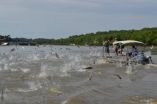(Press-News.org) EAST LANSING, Mich. — Vocabulary instruction in the early years is not challenging enough to prepare students for long-term reading comprehension, argues a study led by a Michigan State University education researcher.
The study, which appears in Elementary School Journal, analyzed commonly used reading curricula in U.S. kindergarten classrooms. It found that, generally, the programs do not teach enough vocabulary words; the words aren't challenging enough; and not enough focus is given to make sure students understand the meaning of the words.
"Vocabulary instruction does not seem to have an important enough role in the curricula given how substantial it is for kids' long-term academic success," said Tanya Wright, MSU assistant professor of teacher education and lead researcher on the study.
The research by Wright and Susan Neuman from the University of Michigan comes on the heels of a National Assessment of Educational Progress report that showed poor and minority students struggle with vocabulary achievement. Low vocabulary scores were associated with low reading comprehension scores on the NAEP test.
Wright said low-income children may start school with 10,000 fewer words than other students and are then exposed to reading programs that teach as few as two vocabulary words per week. She said more than 10 vocabulary words should be taught every week – not just in reading class but across all subject areas including math, science and social studies.
The words should also be more challenging, Wright said. For example, "hysterical" could be used instead of "funny."
"We found that most of the words that are being taught are common words that the kids will learn in everyday language anyway," Wright said.
Further, the study found that not enough attention was given to reviewing vocabulary words – or going back over the words in different contexts – and to monitoring whether the students truly grasped their meanings.
"So you're spending time teaching something," Wright said, "but not spending time checking if the kids ever learned it."
INFORMATION:
Vocabulary instruction failing US students
2013-01-24
ELSE PRESS RELEASES FROM THIS DATE:
Research: Lupus drugs carry no significant cancer risk for patients
2013-01-24
This press release is available in French.
Montreal, January 24, 2013 – People who take immunosuppressive drugs to treat lupus do not necessarily increase their cancer risk according to new research led by scientists at the Research Institute of the McGill University Health Centre (RI-MUHC). This landmark study, which was published in Annals of the Rheumatic Diseases this month, addresses long-standing fears of a link between lupus medication and cancer.
Systemic lupus erythematosus (SLE), commonly known as lupus, is an autoimmune disease in which the body's immune ...
Female mice exposed to BPA by mothers show unexpected characteristics
2013-01-24
ANN ARBOR—Female mice exposed to Bisphenol A through their mother's diet during gestation and lactation were found to be hyperactive, exhibit spontaneous activity and had leaner body mass than those not exposed to the chemical, researchers at the University of Michigan School of Public Health have discovered.
BPA is a chemical most commonly found in the lining of food cans and cash register receipts. It once was in many hard plastic bottles, including baby bottles, but many companies have removed it as concerns about exposure have come to light in recent years.
These ...
Abuse during childhood linked to uterine fibroids in African-American women
2013-01-24
(Boston) – According to a new study from the Slone Epidemiology Center (SEC) at Boston University, African-American women who reported sexual or physical abuse before age 11 had a greater risk of uterine fibroids in adulthood compared with women who had no such abuse history. The association was strongest for women who experienced sexual abuse.
The study, which is published online in the American Journal of Obstetrics and Gynecology, was led by Lauren A. Wise, ScD, senior epidemiologist at SEC and associate professor of epidemiology at the Boston University School of ...
Greenland ice cores provide vision of the future
2013-01-24
Ice cores drilled in the Greenland ice sheet, recounting the history of the last great warming period more than 120,000 years ago, are giving scientists their clearest insight to a world that was warmer than today.
In a paper published today in the journal Nature, scientists have used a 2,540 metre long Greenland ice core to reach back to the Eemian period 115-130 thousand years ago and reconstruct the Greenland temperature and ice sheet extent back through the last interglacial. This period is likely to be comparable in several ways to climatic conditions in the future, ...
Personal epigenetic 'signatures' found consistent in prostate cancer patients' metastases
2013-01-24
In a genome-wide analysis of 13 metastatic prostate cancers, scientists at the Johns Hopkins Kimmel Cancer Center found consistent epigenetic "signatures" across all metastatic tumors in each patient. The discovery of the stable, epigenetic "marks" that sit on the nuclear DNA of cancer cells and alter gene expression, defies a prevailing belief that the marks vary so much within each individual's widespread cancers that they have little or no value as targets for therapy or as biomarkers for treatment response and predicting disease severity.
A report of the discovery, ...
New method of producing nanomagnets for information technology
2013-01-24
Jülich, 23 January 2013 – An international team of researchers has found a new method of producing molecular magnets. Their thin layer systems made of cobalt and an organic material could pave the way for more powerful storage media as well as faster and more energy-efficient processors for information processing. The results of this research have been published in the current issue of the renowned journal Nature (DOI: 10.1038/nature11719).
In order to boost the performance of computers and reduce their energy requirements, processors and storage media have become smaller ...
There were more small meat-eating dinosaurs than first thought
2013-01-24
(Edmonton) University of Alberta researchers used fossilized teeth to identify at least 23 species of small meat-eating dinosaurs that roamed western Canada and the United States, 85 to 65 million years ago.
Until now, only seven species of small two-legged meat-eating dinosaurs from the North American west had been identified.
U of A palaeontologist Philip Currie and student Derek Larson examined a massive dataset of fossil teeth that included samples from members of the families to which Velociraptor and Troodon (possibly the brainiest dinosaur) belong.
"Small meat-eating ...
Underwater CO2 shows potential as barrier to Asian carp
2013-01-24
URBANA – As the Asian carp population grows and the threat of the invasive species entering Lake Michigan through one of the Chicago canals is monitored, a University of Illinois researcher believes using two barrier methods is better than one.
Cory Suski experimented with adding carbon dioxide (CO2) into the water as a supplemental tool to work in tandem with the electric fence, which has been used to divert the carp from entering the canal, with the goal of providing a second line of defense.
Suski found that carbon dioxide is quick and effective in repelling fish ...
Novel aptamer boosts T cell-based immune response to therapeutic vaccines
2013-01-24
New Rochelle, NY, January 22, 2013—A small compound called an aptamer that specifically targets and stimulates a human immune cell can greatly increase the effectiveness of an immunotherapeutic drug designed to destroy malignant or virus-infected cells. The development of a novel apatamer that recognizes activated T-lymphocytes and can boost the therapeutic effect of cell-based vaccines is described in an article in Nucleic Acid Therapeutics, a peer-reviewed journal from Mary Ann Liebert, Inc. publishers (http://www.liebertpub.com). The article is available on the Nucleic ...
Microbiologists eavesdrop on the hidden lives of microbes
2013-01-24
(CAMBRIDGE, MA) -- Microbiologists who study wild marine microbes, as opposed to the lab-grown variety, face enormous challenges in getting a clear picture of the daily activities of their subjects. But a team of scientists from MIT and the Monterey Bay Aquarium Research Institute recently figured out how to make the equivalent of a nature film, showing the simultaneous activities of many coexisting species in their native habitat over time.
Instead of making a movie, the scientists used a robotic device that dangled below the surface of the ocean, drifting in the water ...




